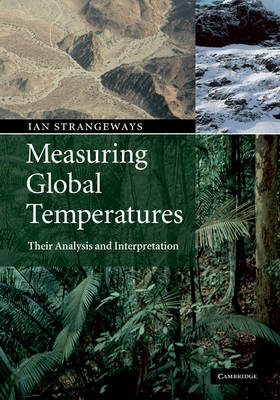
Measuring Global Temperatures
Cambridge University Press (Verlag)
978-0-521-89848-5 (ISBN)
Temperature is probably the most influential of all climatic variables. Our only direct, quantitative knowledge of global temperatures comes from instruments operated over the last 150 or so years. Yet as crucial and as central as these data are to our understanding of the climate, they are largely taken for granted, even by many of those using them. Measuring Global Temperatures will fill this gap by explaining how global temperatures are measured, how the data are analysed, what the potential errors are, and what needs to be done to improve temperature measurement in the future. The book is of great interest to all meteorologists, climatologists, and hydrologists, and especially those concerned with climate change and global warming. It is written in accessible language with little mathematics, and so will appeal to students and amateur meteorologists with a strong interest in weather and climate.
Ian Strangeways obtained his degree in electronic engineering, physics and mathematics from Bangor University, followed by a PhD in meteorological instrumentation from Reading University. After 24 years at the Institute of Hydrology as head of the Applied Physics Section, concerned with measuring the hydrometeorological environment, he became Director of TerraData, a consultancy in meteorological and hydrological data collection. He is also the author of Measuring the Natural Environment, now in its second edition (2003, Cambridge University Press) and Precipitation: Theory, Measurement and Distribution (2007, Cambridge University Press). He has written many papers on the topic of data collection, climate measurement and instrumentation, and has written extensively for the Royal Meteorological Society's (RMetS) magazine Weather, for which he received the Gordon Manley Award in 2005. He is on the committee of the RMetS Special Interest Group on Meteorological Observing Systems, which he also chaired for three years. He has travelled extensively to many remote areas of the world, advising on the monitoring of the weather and rivers, and has given talks at major international conferences. He has been an external lecturer on the subject at Newcastle University, and has also taught at the Open University and instructed students overseas. He is an Associate Fellow of the RMetS and an Associated Member of the British Hydrological Society and the Institution of Civil Engineers.
Preface; 1. The balance of energy; 2. Thermometry; 3. Screens, stands and shelters; 4. Measuring land surface air temperatures; 5. Measuring sea surface and marine air temperatures; 6. Measuring sea temperature profiles; 7. Global instrument networks; 8. From point measurements to global means; 9. Temperature changes since 1850; 10. Temperature profiles through the atmosphere; 11. Future measurements; Appendix A. The gas laws; Appendix B. Relative humidity and dew point; Appendix C. The electromagnetic spectrum; Appendix D. Satellite measurements of surface temperature; Appendix E. Metadata; Appendix F. The southern oscillation index; Index.
| Erscheint lt. Verlag | 12.11.2009 |
|---|---|
| Zusatzinfo | 2 Tables, unspecified; 48 Halftones, unspecified; 28 Line drawings, unspecified |
| Verlagsort | Cambridge |
| Sprache | englisch |
| Maße | 178 x 253 mm |
| Gewicht | 650 g |
| Themenwelt | Naturwissenschaften ► Geowissenschaften ► Meteorologie / Klimatologie |
| ISBN-10 | 0-521-89848-X / 052189848X |
| ISBN-13 | 978-0-521-89848-5 / 9780521898485 |
| Zustand | Neuware |
| Haben Sie eine Frage zum Produkt? |
aus dem Bereich


